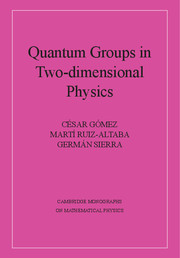Book contents
- Frontmatter
- Contents
- Preface
- 1 S-matrices, spin chains and vertex models
- 2 The Yang–Baxter equation: a first look
- 3 Bethe ansatz: some examples
- 4 The eight-vertex model
- 5 Face models
- 6 Quantum groups: mathematical review
- 7 Integrable models at roots of unity
- 8 Two-dimensional conformal field theories
- 9 Duality in conformal field theories
- 10 Coulomb gas representation
- 11 Quantum groups in conformal field theory
- References
- Index
9 - Duality in conformal field theories
Published online by Cambridge University Press: 08 February 2010
- Frontmatter
- Contents
- Preface
- 1 S-matrices, spin chains and vertex models
- 2 The Yang–Baxter equation: a first look
- 3 Bethe ansatz: some examples
- 4 The eight-vertex model
- 5 Face models
- 6 Quantum groups: mathematical review
- 7 Integrable models at roots of unity
- 8 Two-dimensional conformal field theories
- 9 Duality in conformal field theories
- 10 Coulomb gas representation
- 11 Quantum groups in conformal field theory
- References
- Index
Summary
In chapter 8, we characterized a conformal field theory by its symmetry algebra, namely the Virasoro algebra or, more generally, the chiral algebra. We have seen that in the minimal models of type (p, p′), with central charge c < 1, the existence of degenerate representations of this algebra restricts enormously the operator content of the theory. The construction and classification of conformal field theories can thus be formulated as mathematical problems in the representation theory of infinite-dimensional chiral algebras. This chapter is devoted to a pursuit of this more formal approach to conformal field theories, along the very same lines as the “operator formalism” of string theory.
The operator formalism of conformal field theories produces some simple diagrammatics to describe physical states and their correlation functions. The building blocks for such diagrams are two-dimensional orientable Riemann surfaces, with topology classified by the genus or number of handles and by the number of punctures or local operator insertions. Having the diagrams at hand, one is immediately compelled to analyze the behavior of states and correlators under “dual transformations”, symmetry operations which eventually call for the interpretation of the Riemann surface as the world-sheet of an extended object, the quantum string. Under a duality transformation, for instance, a four-particle correlator on the sphere is mapped to another four-particle correlator. If we think of the correlator as an amplitude for the scattering of two particles into two particles, then through a duality transformation we may map the amplitude in the s channel to that in the t or in the u channels (s, t and u are the Mandelstam variables; see figure 9.1).
- Type
- Chapter
- Information
- Quantum Groups in Two-Dimensional Physics , pp. 308 - 339Publisher: Cambridge University PressPrint publication year: 1996



